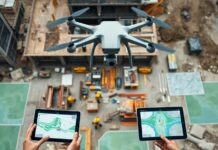The Federal Aviation Administration is pressing its effort to restrict use of unmanned aerial vehicles after it lost a legal ruling regarding regulatory authority over smaller drones. But amid a rising tide of drone usage, including by contractors and engineers, the agency’s fight may prove futile.
In March, an administrative judge with the National Transportation Safety Board dismissed the FAA’s sole attempt to levy a fine of $10,000 against photographer Raphael Pirker for “careless and reckless” operation of a drone at the University of Virginia. In fining Pirker, FAA noted that he operated the UAV through an operating tunnel and below a construction crane and that it almost struck a person. NTSB judge Patrick Gerarghty ruled the FAA lacked authority, concluding that UAVs are model aircraft, which FAA excludes from regulation. Wrote Gerarghty, “The reasonable inference is not that FAA has overlooked the requirements, but, rather, that FAA has distinguished model aircraft as a class excluded from the regulatory and statutory definitions.”
FAA is appealing to the full NTSB board. Pending the outcome, the agency maintains that use of a UAV for anything other than hobby or recreational purposes is “unauthorized” and subject to regulatory action. An agency spokes- person says FAA has authorized only one UAV for operation: Conoco Phillips’ UAV in the Arctic.
Some drone operators say FAA’s model-aircraft guidelines apply. One guideline restricts model-plane flights to altitudes below 400 ft, and some users regard that height as a defining criteria of hobby and recreational use. As argued in the Pirker case, however, the FAA maintains any commercial operation, at any height, is unauthorized.
Still, FAA actions against unauthorized operation are rare. To date, it has sent just 12 cease-and-desist letters and levied only one fine, says a spokesperson.
With the agency increasingly challenged by the expanding use of drones, though, operators show little fear of being caught. “Ask forgiveness later,” says one flyer, Brooks Weisblat, technology director for the Patricia and Phillip Frost Science Museum, Miami. Weisblat recently used a UAV to film aerials of the museum’s $275-million construction project and posted them on YouTube.
Contractors and engineers are exploring the technology. Engineering firm Wilson & Co. has worked with Kansas State University to build and fly a UAV for surveying and mapping a landfill near Manhattan, Kan.
Eric Cenovich, a Kansas City, Mo.-based principal of the firm, says the UAV follows a programmed path at 35 to 40 mph. It can document the 160-acre site in about 40 minutes on one battery charge.
“It dramatically affects the price that smaller areas can be mapped for,” Cenovich says. “It’s easily a 50% reduction.” Moreover, he says, the use of UAVs will eliminate the need for significant investment to enter the surveying-and-mapping business and likely will result in increased competition.
Wilson & Co. has invested millions of dollars in aircraft, cameras and LiDAR mapping tools, Cenovich says. “All of those capital assets and investments that needed to be made to get into this aerial photography and mapping game are no longer going to be applicable for smaller-type projects,” he says. “It’s going to allow a lot more people to get into this.”



























